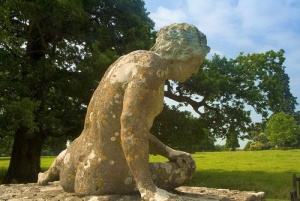"All gardening is a landscape painting"
William Kent

William Kent was born in Bridlington, Yorkshire, in 1685. He trained as a sign painter, and also worked on coaches, before taking up landscape painting. Unfortunately, his talent with the brush was not up to his vision. For 10 years Kent lived and studied painting in Rome while he made a living by buying paintings and selling them to the English aristocracy as house furnishings.
In 1715 Kent met Lord Burlington, and Burlington was so impressed with Kent's artistic vision that he brought the young Yorkshireman back to London with him. There Kent designed and built furniture and temples on a classical theme for Burlington and his friends.
He also continued with his painting, but at Burlington's urging, he branched into architecture, where he became quite fashionable.
Kent's finest architectural work is undoubtedly Holkham Hall, built for the Earl of Leicester in the Palladian style. Architecture then included more than simple house design, and Kent was involved in the creation of interior fittings and furnishings, most designed in an ebullient Baroque fashion.
It is not as an architect that Kent is famous, however, but as the father of the "picturesque", or English landscape garden. Yet Kent was no horticulturalist - he envisioned the landscape as a classical painting, carefully arranged to maximize the artistic effects of light, shape, and colour. He was not above planting dead stumps to create the mood he required.
His gardens were dotted with classical temples replete with philosophical associations, a fact which would have been readily apparent to his learned patrons.
Kent's most important gardening creations were at Stowe, Rousham, and Chiswick House. At Stowe, he smoothed away the rigid lines of the formal gardens to create sinuous shaded walks.
William Kent died in 1748, but his contributions to the 'natural" gardening style which evolved into the English landscape garden cannot be overstated.
Places to see associated with William Kent:
Rousham House, Oxfordshire - the finest surviving example of Kent's "natural" gardening style
Stowe House, Buckinghamshire - much of Kent's gardening work here is overshadowed by later additions, notably by his successor, Capability Brown.
Chiswick House, London
Horse Guards, Whitehall, London
